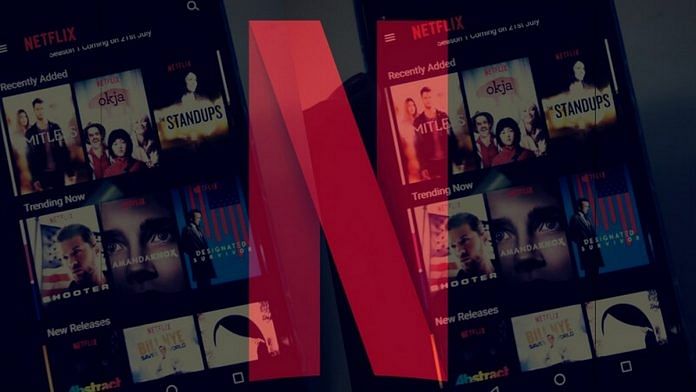New Delhi: When the pandemic struck in 2020, Netflix hit a dramatic 16 million new subscribers in the first quarter of the year. But now, for the first time in a decade, the streaming platform has lost subscribers — 200,000 of them in the first quarter of 2022, according to its letter to shareholders released Tuesday.
Things could get a whole lot worse. The company has predicted it could lose 2 million subscribers in the second quarter. Unsurprisingly, Netflix shares have been plummeting since Tuesday, dropping 39 per cent as of Wednesday.
The company’s letter placed much of the blame for its flagging performance on a large number of households sharing accounts, fierce competition with other streaming platforms, as well as global factors like the Russia-Ukraine war and inflation.
But, how exactly did things go south, especially after the lockdown boom when just about everyone seemed to be on the “Netflix-and-chill” bandwagon? And, what is the company planning to do to retain and grow its subscribers?
Also Read: Macquarie’s Paytm analyst who predicted slump further cuts target price
‘Covid clouded the picture’
In its letter to shareholders, Netflix explained how its revenue growth “slowed considerably” despite the global popularity of many of its titles. Problems had been brewing for a while, the letter suggested, but were not immediately apparent because they were masked by the massive growth in 2020.
“Covid clouded the picture by significantly increasing our growth in 2020, leading us to believe that most of our slowing growth in 2021 was due to the Covid pull forward,” the letter said.
According to Netflix, four major “inter-related factors” led to its current predicament.
Among these were one of the features that make Netflix so popular: the ability to share passwords/accounts. This, the company said, made it harder to “grow membership in many markets — a issue that was obscured by our Covid growth”.
The company also acknowledged that the pace of growth in its “underlying addressable market” — homes with broadband connections — was also affected by extraneous factors like the “uptake of connected TVs… the adoption of on-demand entertainment, and data costs”.
The third factor was the changing face of the competition. The letter explained that Netflix had experienced “robust” competition from “linear TV”, YouTube, Amazon, and Hulu for the past 15 years, but over the last three years many new streaming services had been launched, including from traditional entertainment companies (like Disney).
Finally, Netflix pointed at the likely impact of “macro factors”, including “sluggish economic growth, increasing inflation, geopolitical events such as Russia’s invasion of Ukraine, and some continued disruption from Covid”.
How is Netflix planning to revive itself?
Netflix has asserted that it plans to accelerate its revenue growth by improving its services, and by “more effective monetisation of multi-household sharing”.
The latter likely means that the company is looking to put restrictions on its much-loved password-sharing feature.
Netflix has not explained exactly how it will accomplish this, but there is a hint in the company’s announcement last month that it is launching and testing a new feature in Chile, Peru, and Costa Rica that enables primary account holders to pay to add users outside their household.
In the shareholder letter, too, the company mentions this and the possibility of other unspecified ways to “monetise sharing”, adding that growth in average revenue per member (ARM) and viewing will “become more important indicators of our success than membership growth”.
The company is also looking at the content of its programming. In its Q1 2022 earnings interview video, in which the brass can be seen weighing in on Netflix’s issues, co-CEO and Chief Content Officer Ted Sarandos admits: “We were not happy with the top line subscriber growth… We need to have a Bridgerton and an Adam Project every month…”
Sarandos pointed out that the platform has gained a lot from “unscripted content”, or reality TV shows, which have been growing into “original unscripted universes”.
International content got a mention, too, in the earnings call, especially the potential of markets like Korea. The CEO also mentioned “a nice uptick in India” and high hopes for upcoming titles.
In the letter as well, Netflix mentions that it is still seeing “nice growth” in the Asia Pacific region, including India, Japan, the Philippines, and Thailand.
‘Low-end’ plans with ads may be on the horizon
One of the biggest questions that came up for the Netflix management is whether they should also replicate the ad models of some of their competitors. The idea is to charge users less money for a subscription plan that includes advertisements.
Netflix co-CEO Wilmot Reed Hastings in the earnings call said that “one way to increase the price spread is advertising on low-end plans”.
“We might offer subscriptions at even lower pricing with advertisements,” Hastings said, noting that it might appeal to those who are “advertisement-tolerant”.
“It’s not a short-term fix,” he said, “because once you start offering a lower-priced plan with ads as an option, some consumers take it”.
(Edited by Asavari Singh)
Also Read: Streaming binge-worthy videos does come at a cost. Here’s how it impacts the environment






